If you want to learn how to build an underground room or safe room, you’re probably one of the visionaries who aim to be future-ready. Most of us, at some point, thought about the end of the world, apocalypse, or nuclear warfare.
The concept of the apocalypse is a millennium-old idea that has driven some world leaders to build bunkers for emergency evacuation.
Today, there are tons of hidden underground bunker facilities under known cities like the UK and the 173,000 hidden bunkers in Albania.
Some private individuals were also keen on building a bunker within their property during World War II. In some cases, these bunkers later turned into a root cellar or wine cellar. The modern-day use of underground rooms is for man caves, playrooms, or a working studio.
If you have a yard and aim to make something out of it, check first if your location is suitable for an underground room since it is not for everybody.
Below are the steps on how to build your underground room and bring your visions to life.
Qualifications of a Property To Build an Underground Room
As for every construction work, you must check first if your property can give you the right conditions to build an underground room.
You may have the best vision for your underground room, but when its construction leads to a flooded room or a complicated project, your efforts and resources will only go to waste.
One of the most suitable locations for an underground room is an area frequented by tornadoes. It can help homeowners keep themselves safe under the ground than running outside.
Another option is when you live in areas with wide spaces, top of the hill or a mountain, away from the utility lines underneath the ground and flood.
An underground room may NOT be a suitable option for you if you LIVE in an area with the following conditions:
- Flood area: If your property is in low terrain and usually accumulates water during rainy seasons, your underground room may likely be flooded. There will also be a higher chance for leaks to occur.
- Near bodies of water: The underground water can be a problem once you start digging the soil near large bodies of water. Moisture can also affect the integrity and strength of the walls of your underground room.
- Near trees: Trees have big roots that can make it hard to dig the soil properly. Expect that it will take more than an excavator to achieve the size and depth that you need to set up your underground room.
- Around utility lines: Once your local authorities confirm that your property sits above utility lines, digging around the perimeter can hit crucial pipes and cause new problems.
You must check first if your yard qualifies for an underground room to prevent you from wasting your time, effort, and resources.
Once you confirm that you can build an underground room, you may proceed with the next phase – planning for its purpose.
You might also like: How To Hang A Swing Between Two Trees?
What is The Purpose of Your Underground Room?
Now that your plans for a secret room are suitable for your location, it’s about time to decide about the purpose of your underground room.
Its purpose and function will determine the design and things that you need for construction.
Here are some ideas to choose from:
1. Man Cave
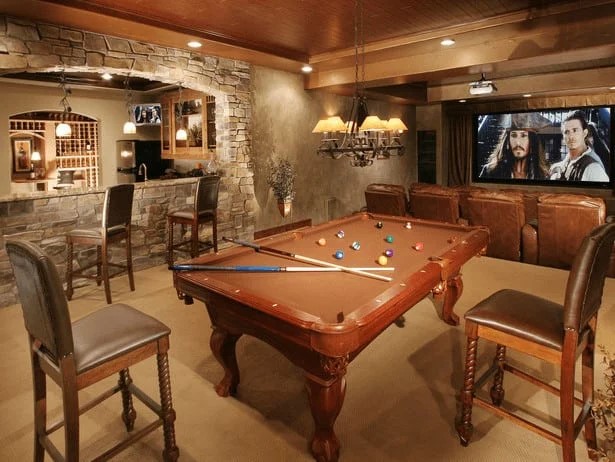
Almost every husband longs for a quiet time in a place of their own and surrounded by their interests.
Some people like the sneakerheads use their underground room to store their collection of rubber shoes, and some use their man cave for games and relaxation. Every husband who works hard also deserves to play hard with their undivided time.
2. Panic Room/Bunker
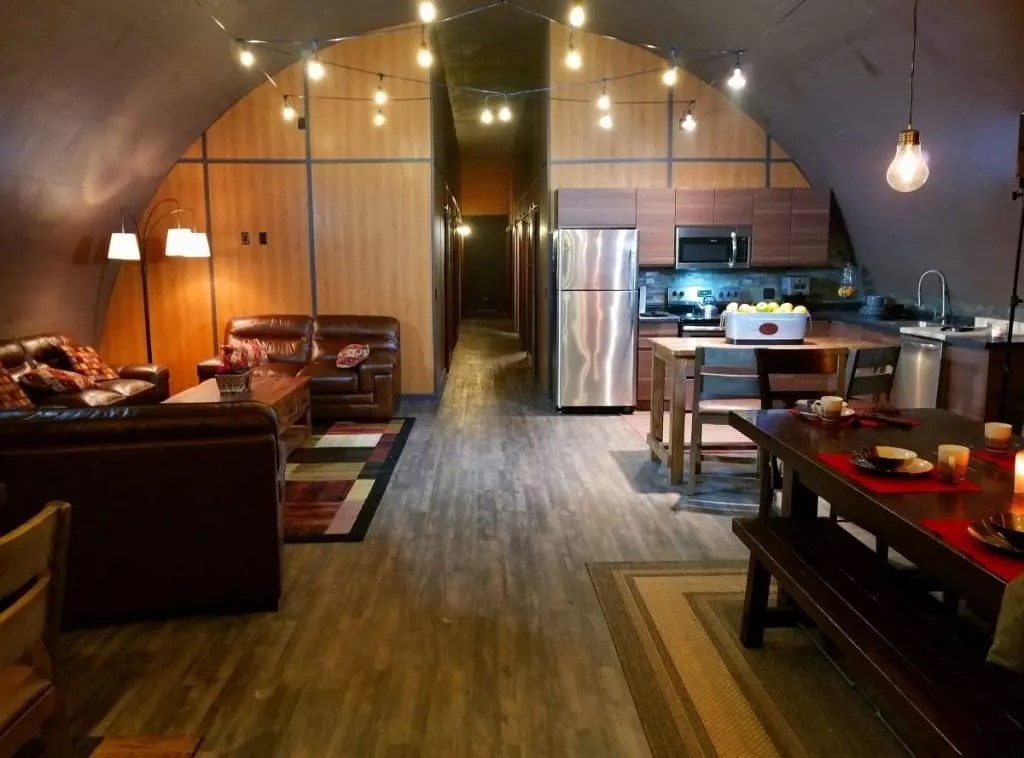
If you want to plan and be ahead of any uncertain circumstances, turning your underground room into a panic room or bunker may give you the security and peace of mind that you are looking for.
You can set up a provision for the necessities such as toilet & bath, mini kitchen, and food storage.
Who knows when the apocalypse happens, right?
3. Cinema Room
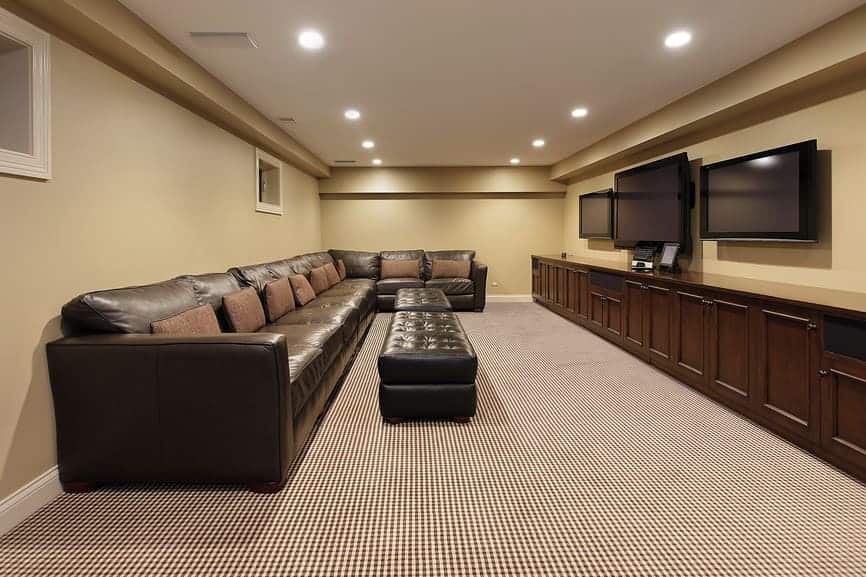
Enjoy watching your favorite shows with a digital surround system with your family by turning your underground room into a cinema room.
The temperature and depth below the ground can make the sound of your audio clearer and level up your movie nights.
4. Underground Office/studio
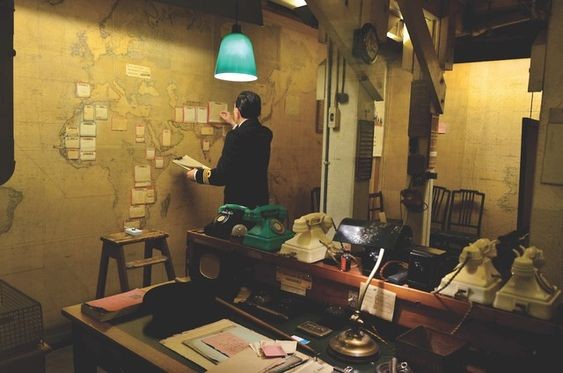
You can turn your underground room into your office. If you’re tired of the usual noise around your house, maybe going underground can give you the peace, quietness, and focus that you need for your work-from-home setup.
If you’re a musician, the underground stillness can also make it easier for you to produce music and rehearse songs without tearing your neighbor’s ears off.
5. Game Room
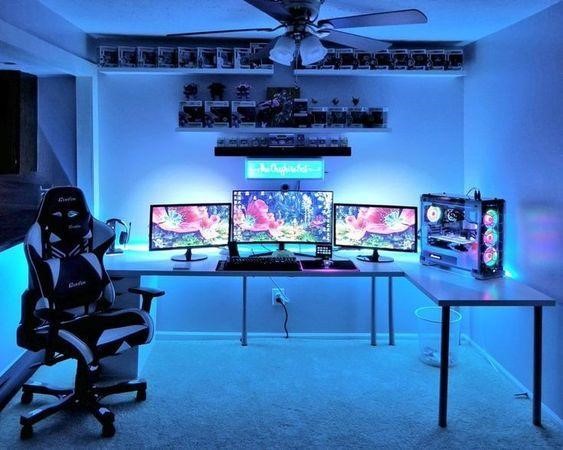
If you are a gamer, your underground room is the perfect setting for your gaming setup.
The backlit desks and multiple monitors will have plenty of space. You will also enjoy uninterrupted gaming streams with your friends while playing Valorant and other co-op games.
How To Build An Underground Room: A Step-By-Step Guide
Once you’ve decided on what you plan for your underground room, it’s time to build!
There are now a lot of companies that provide ready-made bunkers that you can use for various purposes. However, if you got the skill and the stamina, a DIY approach can also work in your favor.
So, the first on the list of building an underground room is choosing your construction strategy. Learn more below:
#1 Decide Between a Ready-Made Bunker or a DIY Underground Room
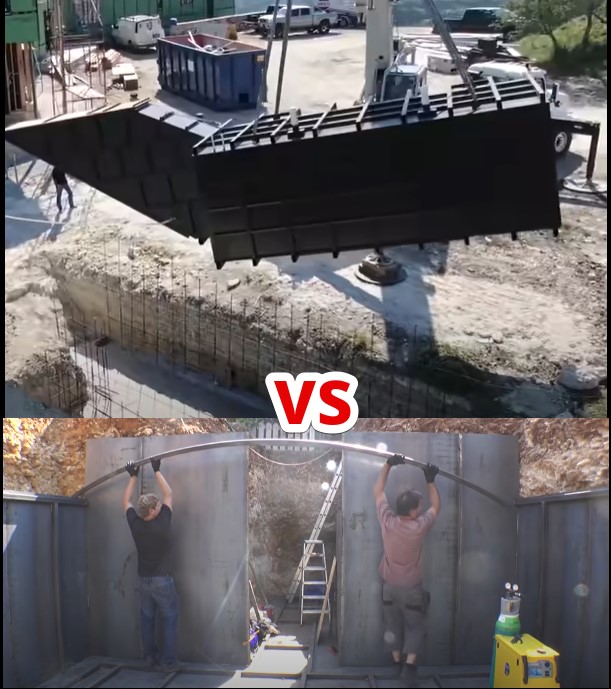
Source: Colinfurze, OfftheRanch
Some companies can already cut off your construction woes by providing you with the whole bunker or underground room. All you need to do is to dig the soil and prepare its bed underneath with reinforced concrete.
The surrounding wall of a ready-made bunker should be poured with concrete with reinforced bars for security and to prolong its lifespan.
The benefits of having ready-made bunkers are as follows:
- More durable since it is designed to be buried in the ground.
- Can be placed deep into the soil, reaching 20 feet.
- May have provision for air filters and water and gas-tight doors.
- Ready to use as soon as the bunker gets delivered to your property.
- May come with built-in storage for water tanks and food storage underneath the floor.
Companies like Rising S Company and Atlas Survival Shelters can help you find the right bunker size for you.
In some cases, you can find some ready-made storm shelters in Amazon, like the Granger Plastics In-ground Tornado Shelter.
The downsides of buying a ready-made bunker are as follows:
- More expensive than DIY underground rooms (price ranges from $30,000 to $130,000)
- May not showcase the features that you want for your underground room
- The size of the average bunker may be too big for your yard
With a DIY underground room, you can change it based on your design and connect it to another part of the house.
You may also buy some plans and create your DIY bomb shelter in your yard from DIY Plans. Making an underground room is not rocket science and takes a lot of considerations such as:
- Condensation
- Heat and cold temperatures
- Hot air during winter and cold air in the winter
- Gamma radiation
- Power source
- Plumbing
If you have the money and aim to build an underground room as a shelter against biological warfare or airborne pandemic, buying a ready-made bunker is the best option.
However, if you are only doing an underground room for a man cave or underground entertainment space, building it from scratch can be a fun project to do with your friends.
The pros and cons of DIY underground room projects include:
Pros
- Low-cost
- Design modification
- Mastery of the location of every feature
- Privacy on each room feature that you wish to place in the underground room
Cons
- Requires additional manpower to dig, reinforce, and build the walls
- Safety risks if the bunker was not done with the appropriate standards
- Take several days or months before completion
- Too technical to construct for inexperienced homeowners
- Pushing through the project without the proper knowledge can cause the project to fail
#2 Get The Permits That You Need To Prevent Problems With Utility Lines
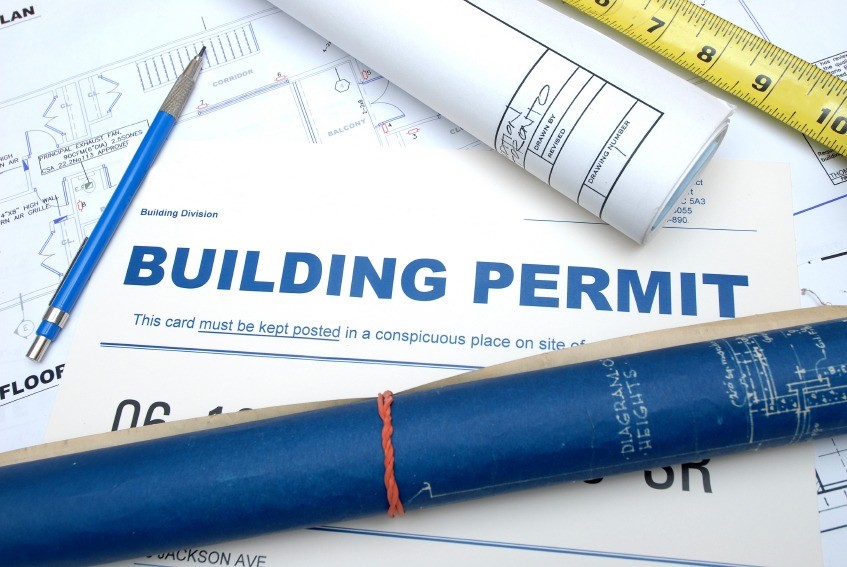
Digging in your yard may cause noises that may disturb your neighbors and surrounding area. Make sure that you have proper permits so your neighbors will not have a ticket to sue you.
There are also some chances of hitting a utility line if you are not careful. So, one of the best things to initially do is to acquire the permits needed for the underground room.
The permits involved in building an additional structure in your property include:
- Building permit
- Discretionary permit
Before doing anything on the ground, make sure to call 811 first to secure a safe and hassle-free construction of your underground project.
According to the code in building fallout shelters, you must submit two sets of plans that include a plot plan showing the location of the proposed bunker, sewer pipes, gas, and water lines, drainage channels, easements, and other buildings on the property.
Every state and city has its rules when it comes to building an underground facility. To learn more about your local laws for building underground facilities, visit your nearest municipal hall for more details.
#3 Spot The Best Location in Your Yard and Design a Floor Plan or Blueprint
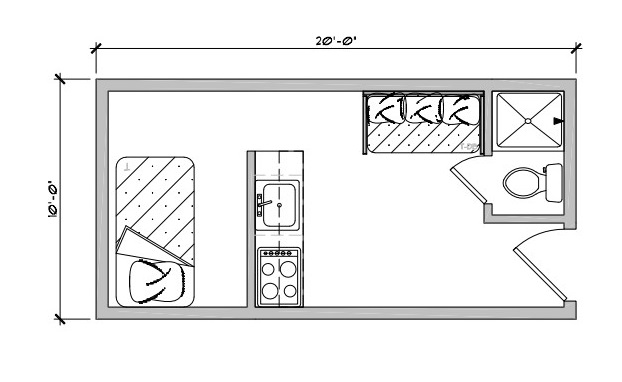
Once you have the green signal from your local authorities, your underground room project can now start to become a reality.
Design your floor plan with the help of AutoCAD or Adobe Photoshop. Make sure that you measure everything accurately and not based on estimation.
Consider the following features when creating your plan:
- Ventilation
- Plumbing
- Power source
- Entryways
- Storage areas
- Electrical design
Most homeowners use the floor of their shed as the entryway to their bunkers. You can also do the same or create a hatch somewhere on your lawn where you can access your underground room.
The complexity of your design will depend on the purpose of your underground room. If you plan to stay there for only a couple of hours, you no longer need heavy equipment for your air filtration and plumbing. The time you spend in the underground room will also determine the features you need. The longer you stay, the more you need certain regulators.
Your daily needs must be met if the purpose of the underground room is to be a survival shelter. It should sustain your everyday living conditions such as proper ventilation, water source, and electricity.
#4 Pick The Right Material For The Walls of Your Bunker
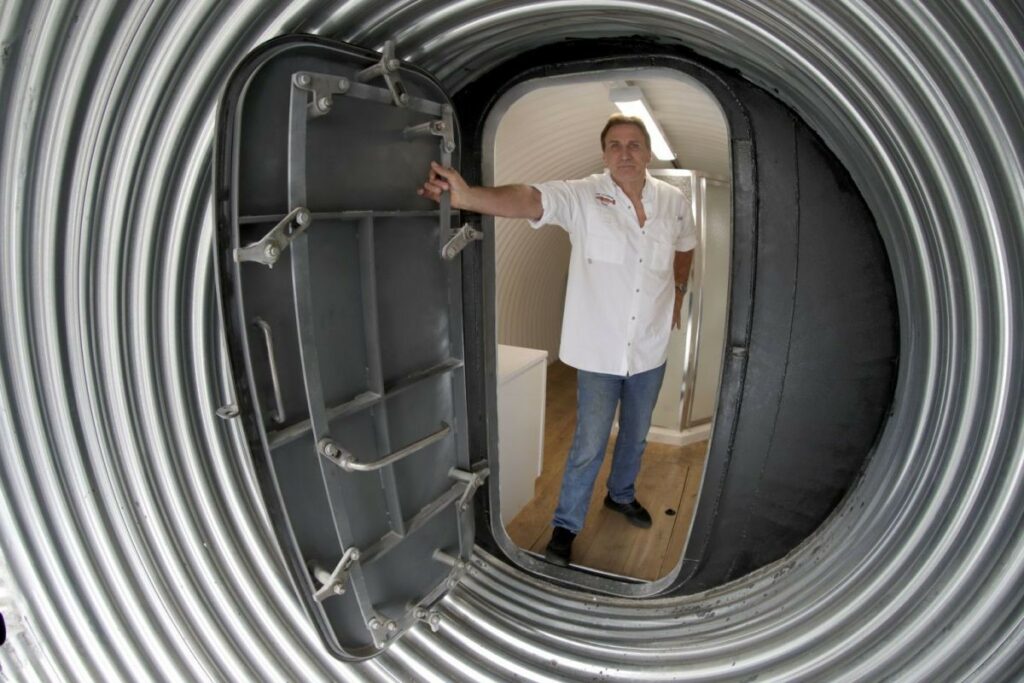
The material that you will use for the walls of your underground room will be the basis of its durability. Every type of material has its pros and cons.
The best one for you depends on your budget and the design of your underground room.
Common materials used are as follows:
- Steel: Most bunker providers in the marker use steel due to its durability and strength that can withstand the soil above the bunker. However, it is expensive and may require insulation for every season.
- Concrete: Concrete walls are cheaper than steel. It also doesn’t rust. However, moisture from the soil can get through the underground room without a proper sealing process. The foundation of the walls may also need to be thicker to sustain its weight which means more cost.
- Bricks: Bricks are one of the tried and tested durable materials for building construction. They are a perfect insulator and also as sturdy as concrete. They can also provide a unique aesthetic to your underground room.
- Corrugated pipe: Corrugated steel pipes are durable materials used by bunker suppliers for their bunkers that can be buried 20 feet below the ground. They are among the most durable materials but also come with an extra cost.
#5 It’s Time To Dig
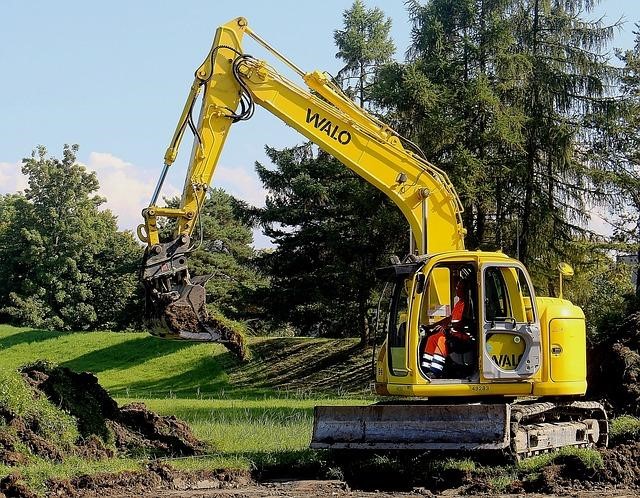
To make the digging faster and more precise, you can hire an extractor to dig the soil for you. Digging too deep in the ground can be dangerous for a DIY underground bunker due to the risk of the ceiling caving in.
The average depth of most underground rooms is 3 feet. Going over that height is risky and should be planned carefully and strategically.
#6 Reinforce The Whole Bunker
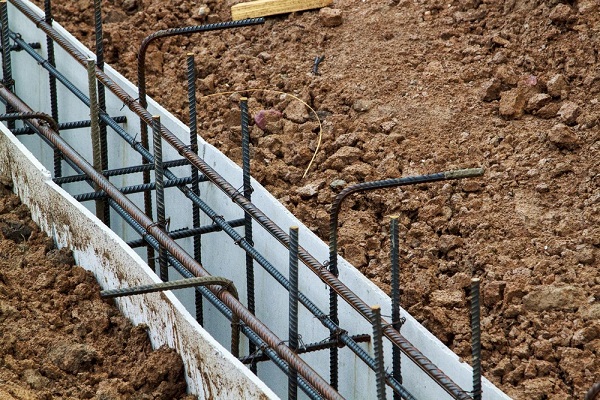
To ensure that the walls and ceiling can bear the weight and pressure from the surrounding soil, you must reinforce them with sturdy materials.
Otherwise, external factors that can move the ground can risk your underground room to move or collapse.
Ready-made or not, an underground room must be secured with concrete from its bottom, sides, and walls.
#7 Prevent Flooding By Waterproofing The Ceiling or Roof and The Door

To prevent the water from leaking to the concrete, make sure to seal the top of your underground room with a tarp or any waterproofing plastic.
Place it before putting back the soil on top of your bunker so that rain or shine, your underground room will remain dry.
#8 Sustain Your Basic Needs With The Crucial Living Necessities
Once you finished building the structure, the next thing that you need to fix is the essential functionalities such as:
(A) Temperature control/insulation: If you used steel as the walls of your underground room, you must prepare additional materials to insulate the room. Since the steel has poor insulating quality, it will be too hot for you to stay in your underground room during summer and too cold in the winter.
(B) Air ventilation/filtration: Make sure that there is enough ventilation that comes to and from the surface. Without proper ventilation, the air will be too thin for you to breathe and cause you to pass out due to lack of oxygen. You should also ensure that the ventilation holes will not be clogged by debris to prevent accidents.
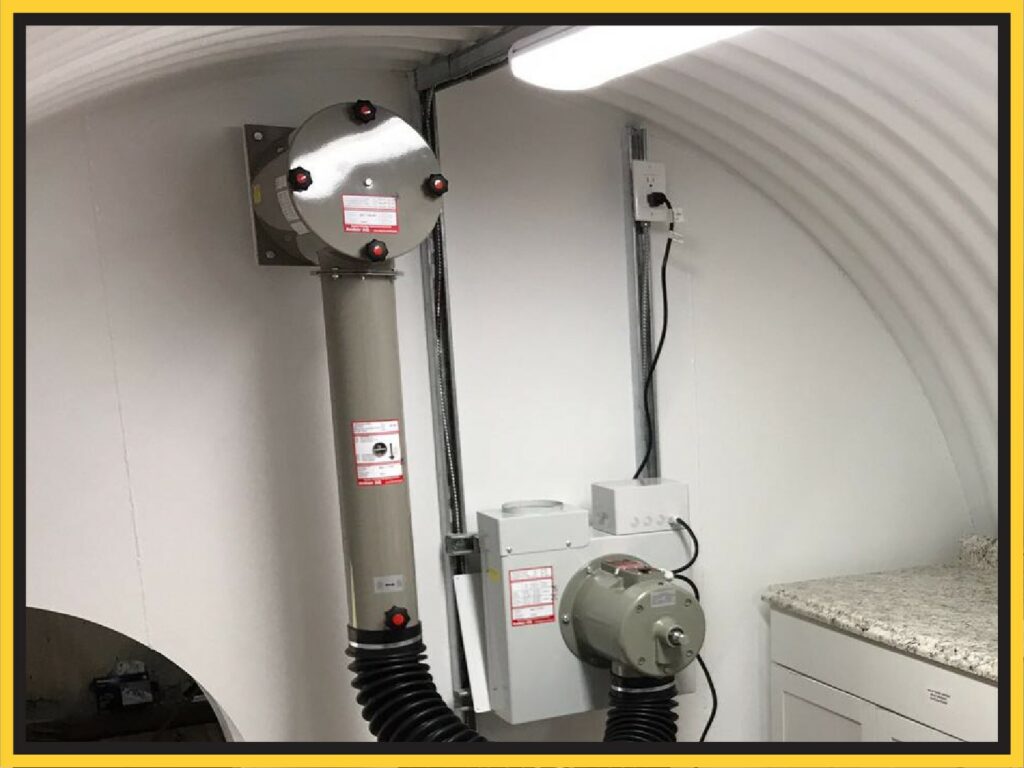
Source: Atlas Survival Shelter
(C) Electrical wiring: You should also have an electrical plan in place to prevent fire and accidents due to electrical wiring. You should plan the location of every socket and switch strategically and where you can conveniently access them.
(D) Power source: Do you plan to stay in your underground room for several days? Then, having a generator in place would be a safe step to take. You may also connect it to your main power line. However, you must ensure equal power distribution for every circuit breaker to avoid circuit overload and fire.
(E) Plumbing: Lastly, if you’re planning to live in your underground room in case of emergencies, your water supply and plumbing are very crucial. You must consult your local water provider on how you can extend your water supply and sewage system to your bunker.
#9 Finish The Interior Design Based on Its Purpose
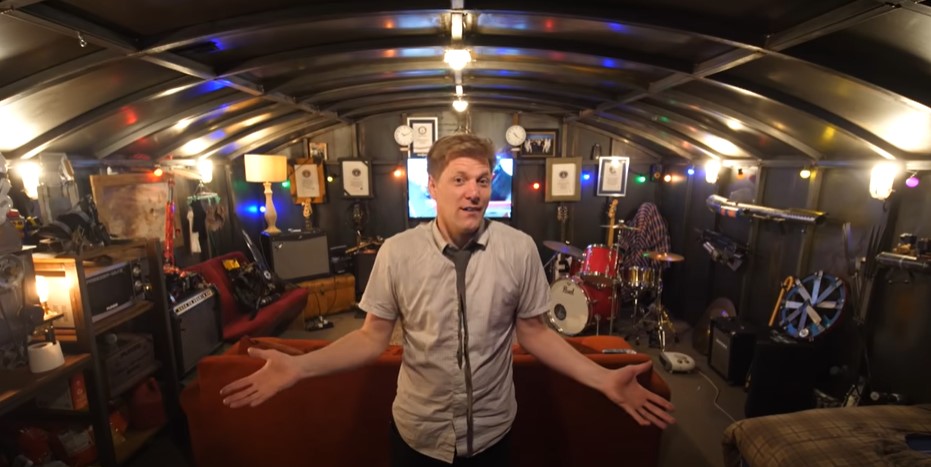
Source: ColinFurze
Designing your underground room is the fun part. You can now transform your underground room and make your visions into reality.
Paint the walls based on your preference and place the furniture whenever you deem fit. The best part about it all is even if you mess up with your design, no one will see it underground.
#10 Enjoy a Cozy Night of Games and Movies with Your Friends in Your New Space Underground
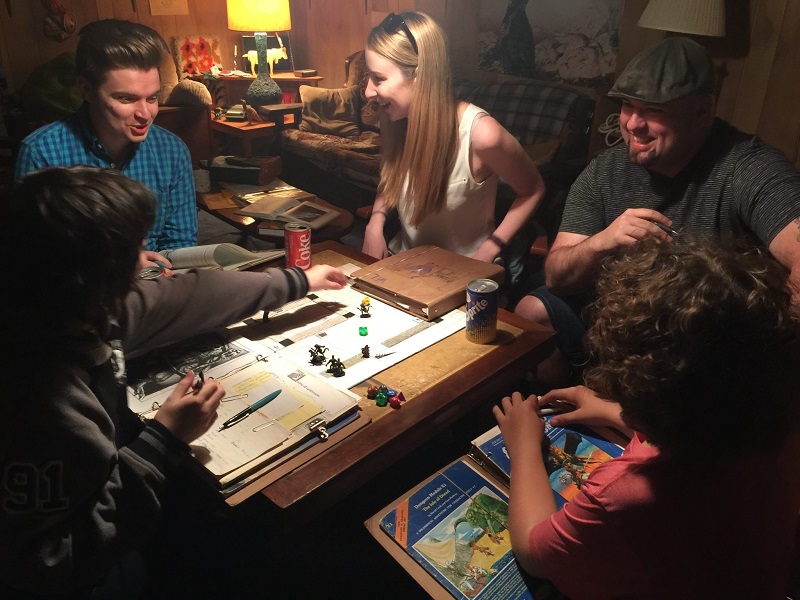
Source: Dread Central – Stranger Things set
Now that you’ve finished your dream project, it’s now time to have some fun with your friends by playing board games or video games to your heart’s content.
Nothing beats the feeling of using something that you’ve built from scratch, especially if it will give you your precious privacy.
Did you enjoy learning how to build an underground room?
Well, it’s now time to execute your dreams and make them happen. Gather around with your friends and family and construct your new space underground.
If you enjoyed reading this post, please share it with your friends, and don’t forget to leave a comment below.
How did you use your underground room? We’re excited to learn more about your journey in building yours!
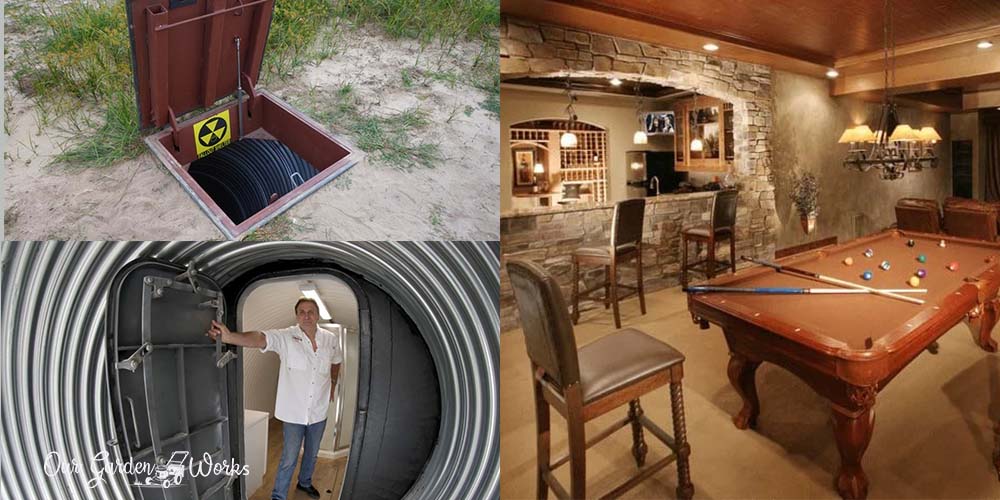
Underground rooms can be a great addition to any home, providing extra space and privacy. Personally, I think they’re a lot of fun to build, too. Great job on this post. You covered everything from start to finish.
I recently moved to an area that often encounters storms and heavy rains, so I wanted to get a below-ground storm shelter built to protect us during such situations in the future. I found it helpful when you told us that we can set up a provision for the necessities in our underground room, such as a toilet and bath, a mini kitchen, and food storage to be ready for uncertain circumstances. I’ll make sure to take note of this while I look for services to call for below-ground storm shelters soon.